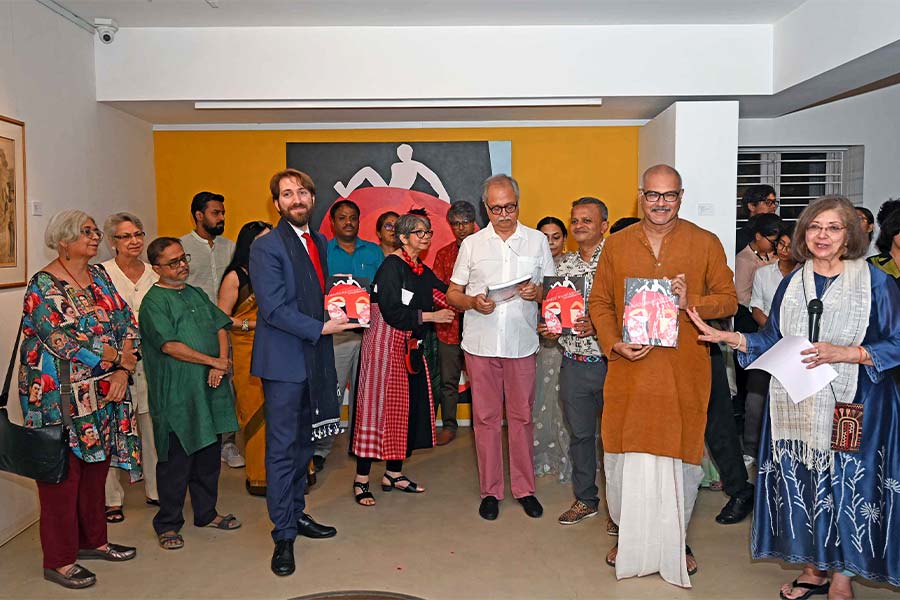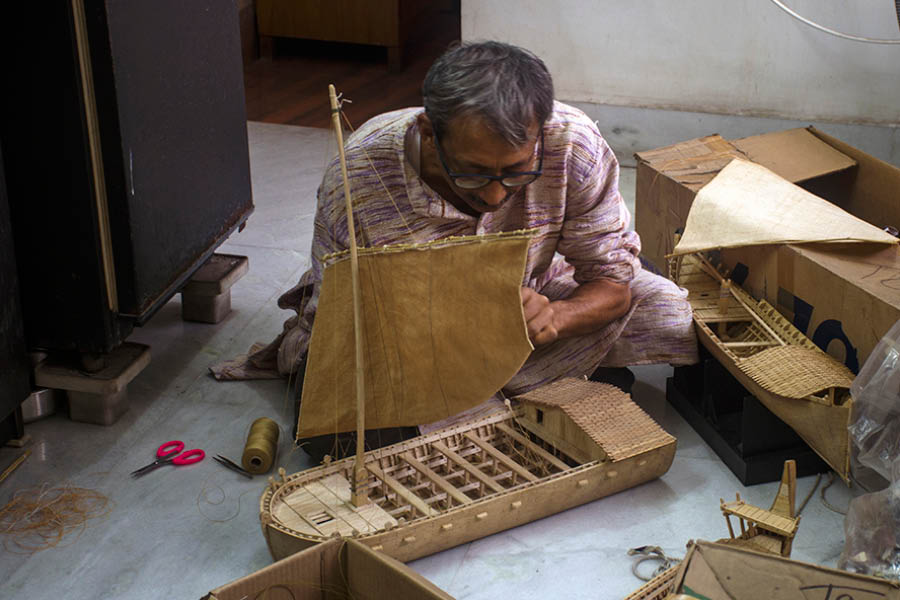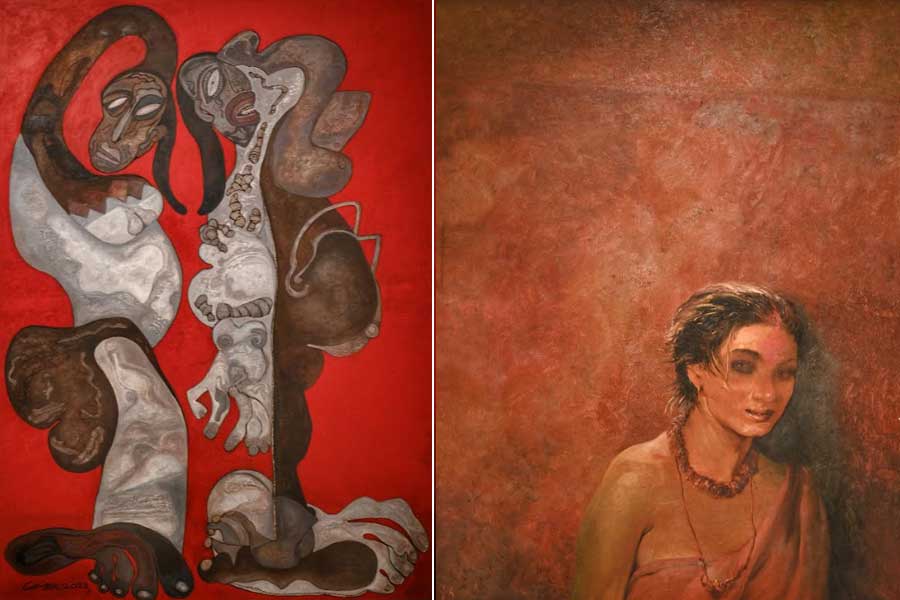“The best way to discover a city is through its art,” said Pratiti Basu Sarkar, chief administrator of the Centre of International Modern Art (CIMA), at the inauguration of Fantastic Realities & Beyond.
Her words set the tone for what was to follow, as the exhibition — mounted on a stunning scale to mark the conclusion of the gallery’s 30th anniversary — was officially inaugurated by the Italian consul general in Kolkata, Riccardo Dalla Costa, in the presence of the CIMA director, Rakhi Sarkar, the chancellor of Ashoka University, Rudrangshu Mukherjee, professor of English Niladri Chatterjee, writer Sandip Roy and some of the artists whose works are on display.
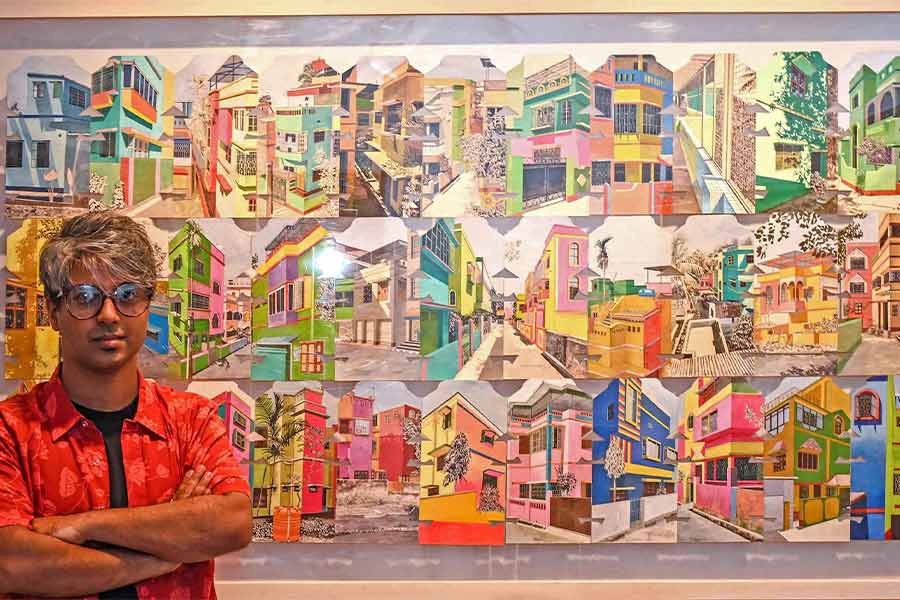
Ankan Bandopadhyay with his work, Sundarban to Sonarpur, gouache on paper, 34 x 72 inches (2023)
A journey of three decades in pursuit of foregrounding the excellence and multifarious nature of contemporary Indian art would have involved not just a monumental degree of determination, but also a vast expanse of inspirations and challenges — a diversity of experience that is reflected in the distinct nature of the works on display, across Kolkata and Delhi.
“To provide a holistic overview, Fantastic Realities features the works of over 50 artists — some celebrated, some young, some even anonymous,” said Rakhi Sarkar. “It points towards a profound psychological dilemma in the contemporary world, and questions it with humour, irony, and occasionally, utter shock,” she added.
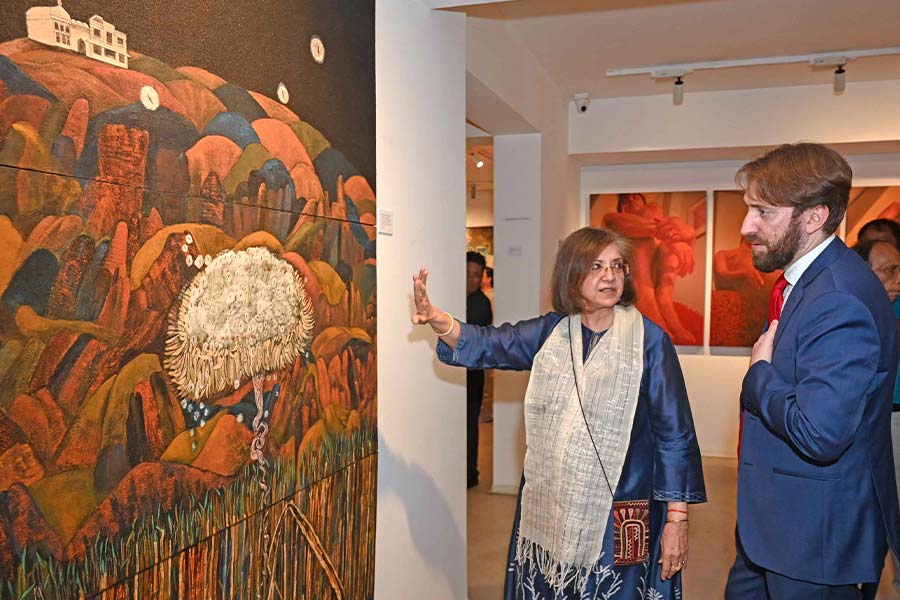
Rakhi Sarkar shows Riccardo Dalla Costa the 2006 work by Rashmi Bagchi Sarkar, Hope for a Flower Float, Iwa-enogu, stone pigment, natural glue over cotton stretched on panel (triptych), 77.6 x 48 inches
The nature of observing and examining the human condition, and everything that informs it, can never be linear. It grows in all directions — sometimes treading well-worn paths and asking age-old questions, at other times alighting on uncertain terrain and carving out new forms of inquiry. Fantastic Realities & Beyond, much like the journey that led to it, adopts a similar, amorphous approach. It enables the viewer to reject linearity and begin anywhere within the exhibition space, led by instinct and the eye, confident that all permutations and combinations will lead to a space of reflection — and, perhaps, some answers, however unsettling.
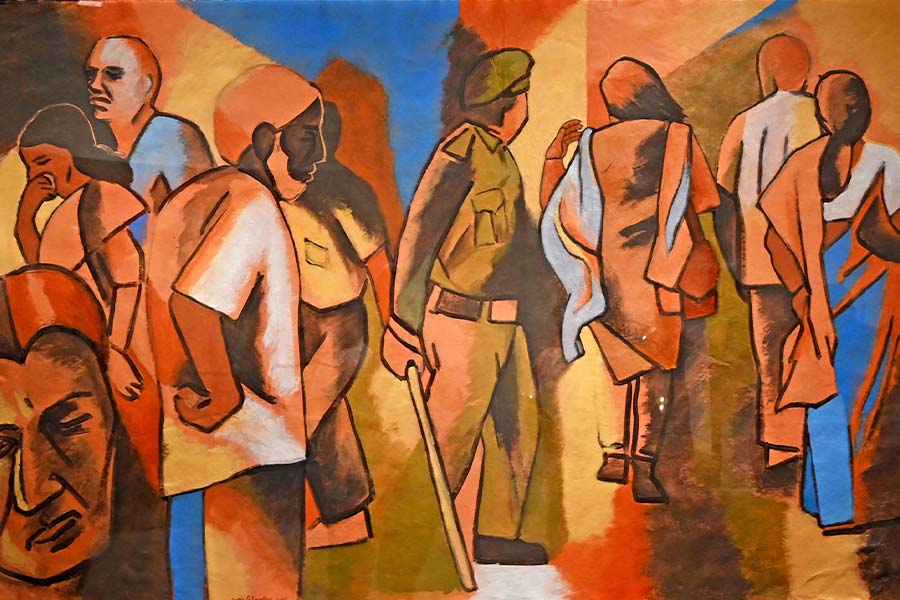
Sudhir Patwardhan’s Pedestrians, acrylic on handmade paper (38 x 66 inches), 2023
This openness to several narrative threads forges a pulsating space of equity in storytelling, which, in an ideal world, would be the cornerstone of art. CIMA’s 30th anniversary show attempts to create such a space, and in crucial ways, succeeds in doing so. Thus, the works of stalwarts such as Ganesh Pyne, Bikash Bhattacharjee, Jatin Das, Jogen Chowdhury, Anupam Sud, Paresh Maity, Atul Dodiya, K.G. Subramanyan and Shobha Broota shall share space in this evolving exhibition with the creations of Ankan Bandopadhyay, Suman Chandra, Shakila Sheikh and Manish Moitra, among many others.
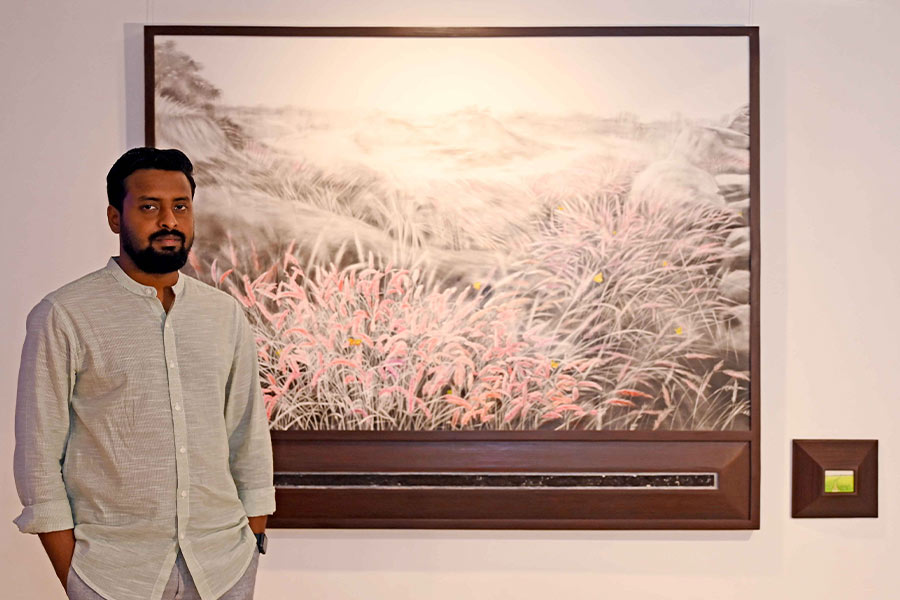
Suman Chandra with his work, Land-escape, charcoal, acrylic, coal dust and watercolour on Italian linen, (large frame 60 x 72 inches, small frame 2.5 x 3.5 inches), 2024
Indeed, this expansiveness of inquiry encourages a democratisation of art that allows every artist to be heard, and, in turn, make space for their contemporaries to be heard, in spite of — or, perhaps, because of — the differences in their concerns, inspirations and artistic inquiry. Thus, while the shock and debilitating nature of illness leads to an artist finding other forms of expression beyond writing (Buku Sarkar, Containment Diaries, print on archival paper, 2021-22), another artist harnesses his lifelong exposure to coal and its mining to ask discomfiting questions about the practice (Suman Chandra, Land-escape, charcoal, acrylic, coal dust and watercolour on Italian linen, 2024). While the almost ephemeral and translucent nature of Sarkar’s photography strikes the viewer with its wispy shadows and sharp melancholy, Chandra, who won the CIMA Awards in 2022, depicts lushness, destruction and regeneration in his work — a cycle that some swathes of denuded, mined land can witness.
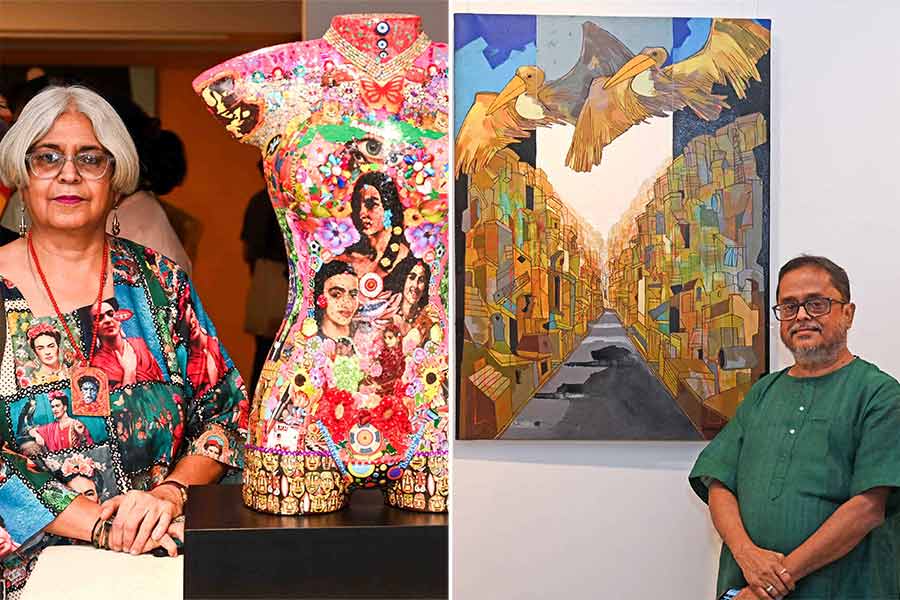
Kanchan Chander with her sculpture, Frida & Amrita 2, mixed media on fibreglass (18 x 24 x 8 inches), 2023 (left); Ashoke Mullick with his work, Petrified City, acrylic on canvas (40 x 30 inches), 2018 (right)
Another marked characteristic of Fantastic Realities & Beyond is its robust representation of the work of women. From printmakers and photographers to sculptors and painters, CIMA’s 30th anniversary show takes a determined step towards negating the (often deliberate) erasure of women from India’s arts space. Delhi-based printmaker Kanchan Chander’s fibreglass sculpture, Frida and Amrita 2, immediately catches the eye. This is not just for its vibrant homage to Frida Kahlo and Amrita Sher-gil, who inspire a bulk of her work — it is also for the singularity of the female gaze and the freedom it brings with it. Having worked with women’s torsos for a significant part of her artistic career, Chander’s art brings to the observer a curious sense of relief — stemming, perhaps, from her expert claiming and adorning of the female form, which, to many women viewers, would mark a welcome departure from the sexualised moulding of women’s bodies through the gaze of male artists.
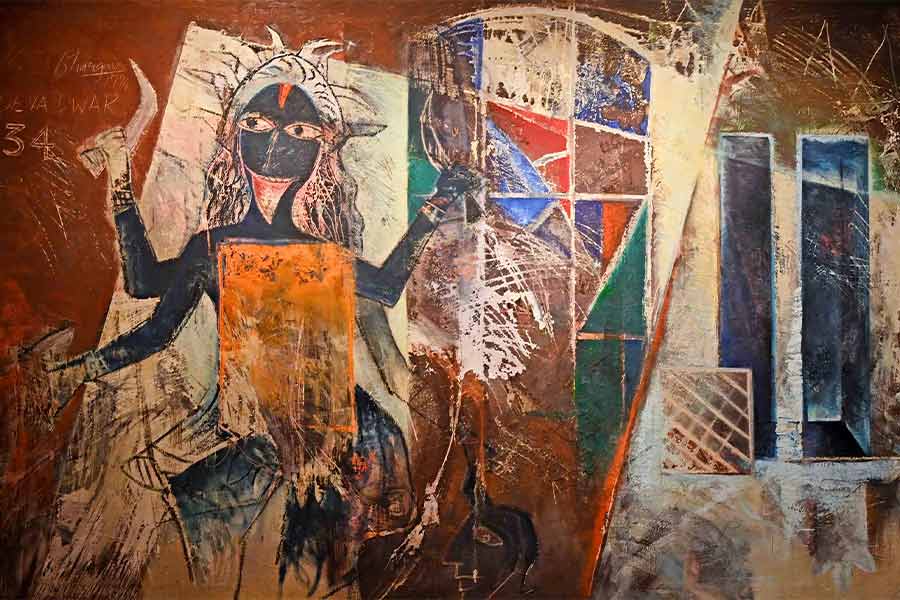
Veena Bhargava’s Deva Dwar Series I, oil encaustic and oil stick on canvas (50.4 x 79.9 inches), 1994
Several of the works on display also bring together the fundamental tenet of the exhibition — the ground on which the fantastic meets the real. Do the two remain distinct even when they come face to face? Or do they merge to create a third, more phantasmagoric, depiction of the human experience? Kolkata-based artist Veena Bhargava’s imagining of the goddess Kali in Deva Dwar Series I brings these questions to mind, with its expert washes of bright and dark hues that are often interrupted by lines and scratches, taking the viewer into the limbo that often exists in the act of worship — the space between sleep and wakefulness. Another depiction of Kali worth mentioning, although it has not yet been mounted at CIMA, is the untitled work of the gifted Shakila Sheikh, a former pavement dweller, whose remarkable journey — aided by CIMA — towards becoming an internationally-recognised artist would be considered the stuff of fantasy if it were not, in fact, a reality.

Rakhi Sarkar with artists Jaya Ganguly and Shreyasi Chatterjee, both of whom are exhibiting at the 30th anniversary show. In the frame is visible Ganguly’s untitled work (mixed media on canvas, 54 x 54 inches, 2023)

Shailendra Kumar’s Jalasen Ghat, print on archival paper, edition 1 of 4 (26 x 40 inches), 2022
But one of the most striking features of Fantastic Realities & Beyond is its artists’ negotiations with city spaces — their skylines, their roads, their colours, sorrows and darknesses. It is these elements which, even in their whimsicality, tell stories, real and imagined, of lived experiences. Ashoke Mullick’s Petrified City, with its clear influences of German expressionism, plays with lines, shadows and patches of light to evoke the starkness and mundaneness of the daily grind — the persistent fears, the sharp terrors and the sense of looming dread that most inhabitants of a city live with as they traverse its streets. And then there is Ankan Bandopadhyay. His Sundarban to Sonarpur series delights the viewer on many counts, be it his beautiful use of colours or his utilisation of sandesh boxes as a medium. The work, however, also tells a tale of migration and isolation. “When I look outside, through the window, I see a lot of colourful houses standing in their loneliness throughout the day; many of their residents have left to work in different parts of India and abroad,” says Bandopadhyay. “The once-bustling streets now stand empty, as do the vibrant homes on the outskirts of Kolkata, once filled with life. They echo the departure of a generation in pursuit of greener pastures.” His art, focusing on the stories of brightly coloured houses in Sonarpur, where folk from the Sunderbans have now come to live, investigates the impact of desertion and loneliness on the cityscape, evident in his incredible eye for detail.

Goutam Pramanick’s Ragging is Not Good for Friendship, tempera on paper, (44 x 30 inches), 2021-22 (left); Jatin Das’s The Seer and the Seen, watercolour on paper (28.7 x 21.7 inches), 2005 (right)
In many ways, the story of Fantastic Realities & Beyond does get distilled to the city — the city of people’s imaginations, the cities from which many of the artists hail, and of course, the city where the CIMA journey started — Kolkata. “I encounter fantastic realities when I walk through the city’s streets and neighbourhoods in the mornings,” said Pratiti Basu Sarkar. “Encountering these realities awakens my body, but more so my mind; it takes me, somehow, beyond myself. I feel a similar sense as I roam through the artworks here. It is my hope that viewers will feel the same as they wander through this exhibition,” she signed off.
Fantastic Realities & Beyond is an evolving exhibition, and is on display at CIMA Art Gallery till August 3, 2024
